Expert Series: Professor Andrew Perkins on MPN
It’s emerging in all cancers, but particularly in the MPNs, that “genomics is everything” according to Professor Andrew Perkins, an expert in myeloproliferative neoplasms (MPN).
And for that reason, he says next generation sequencing (NGS) needs to be funded through the Medicare Benefits Schedule (MBS) for all myelofibrosis (MF) patients in Australia.
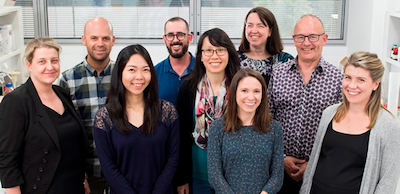
“The common JAK2 gene mutation drives about 50% of myelofibrosis cases, but there’s a whole swag of 30 or 40 other genes that are important to know about,” said Prof. Perkins, Director of Genomic Medicine at the Alfred Hospital (Melbourne).
“We need to know about a combination of mutations that are very good at predicting your five- or 10-year survival, since these are critical to inform treatment decisions.
“If you have a mutation in these genes, your myelofibrosis can progress quickly to either acute leukaemia or just get worse, despite treatment with approved JAK inhibitors such as ruxolitinib (Jakavi®).
“Here at the Alfred, we do a full NGS screen on everybody with myelofibrosis and those with polycythaemia vera (PV) or essential thrombocythaemia (ET) “on the bad end of the spectrum clinically”.
Prof. Perkins explained that someone with PV that is very hard to control on hydroxyurea, or who has a large spleen, or doesn’t feel very well, or is part of the way towards myelofibrosis, would have a full screen, “to try and help them make a decision about what their future looks like and what they should do, including a bone marrow transplant”.
“A group of us, including Piers Blombery, David Ross, Steven Lane, and others, with sponsorship by the Australasian Leukaemia & Lymphoma Group (ALLG), wrote a paper for the Australian haematology and pathology community that was published in April in the journal, Pathology.”
The article outlined recommendations of what should be on a genomic test for new patients with MPN, i.e., what’s important and what isn’t, and why it’s important to know more genetics than just JAK2 in managing a patient”.
“Some MPN patients are keen advocates for NGS and have been involved in applications to government for funding it. It currently costs $500-$1,000 to get the test done, said Prof. Perkins.
“It’s not funded and that’s a problem because it should be.”
Genomics and the myeloproliferative neoplasms
Prof. Perkins said, “MPNs are more complicated than they used to be, there’s a whole spectrum of diseases, so the first thing genomics does is classify them properly”.
The diagnosis of ET, PV, and MF is relatively straight forward but there are a whole lot of overlap syndromes that are best diagnosed with NGS. These include juvenile myelomonocytic leukaemia, chronic myelomonocytic leukaemia, and chronic neutrophilic leukaemia, which have a specific mutation in one gene “nearly all the time”.
“And then there are ‘sideroblastic anaemia’ overlaps,” said Prof. Perkins.
“There is a molecular component to classification which is often missed. Sometimes I see patients who have had a misdiagnosis of standard myelofibrosis for many years, when they actually have a slightly different diagnosis which would have been picked up on an NGS panel.
“NGS is also valuable for prognosis, i.e., whether something’s going to go wrong and turn the disease into leukaemia in the near future or not.”
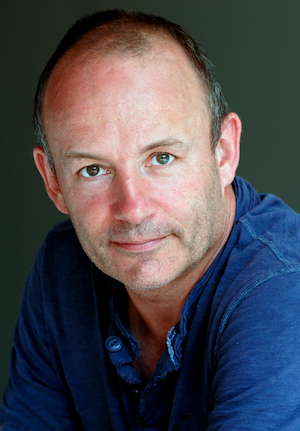
Prof. Perkins said NGS was also useful to reverse an incorrect diagnosis of ET patients made sometimes 10 or 20 years earlier. In these cases, testing has a great outcome for the patient.
“I look at them and say, ‘you’ve been on hydroxyurea for 20 years. I wonder if the diagnosis is wrong?’.”
This can happen occasionally when the original diagnosis was made in the context of severe sepsis or trauma. In these cases, the high platelet count is reactive. NGS can help prove the thrombocytosis is reactive rather than due to a cancer mutation.
“By having a really comprehensive genetic test, and these tests have only come to the fore in the last five years, you can confidently tell the patient, ‘there’s nothing wrong with you, you can stop taking your medication’, and the patient goes back to normal life expectations,” said Prof. Perkins.
“Even simple iron deficiency can sometimes elevate one’s platelet count and there’s really nothing wrong except iron deficiency.”
Professor Perkins’ 30-year haematology and science career in a nutshell
Following his initial training in medicine in Sydney, Prof. Perkins enjoyed learning about the genetics of leukaemia, “when little was known about it”. His PhD at the Walter and Eliza Hall Institute (Melbourne) was in the basic science of genetics in cancer, followed by a postdoc at Harvard University (Boston Children’s Hospital) in developmental genetics of blood disorders.
“I’ve had a clinician/science career since I came back to Australia. I spend roughly half my time doing science and half my time doing haematology. Currently, I’m at the Alfred Hospital 50% of the time, where I’m the Director of Genomic Medicine, which basically means the head of molecular pathology service,” he said.
“The other half of my time, I run a research group at Monash University’s Australian Centre for Blood Diseases. We’re following up on functional validation of mutations, to understand whether they’re pathogenic and disease-causing, or not.
“I became interested in myeloproliferative neoplasms about 12 years ago, when I was at Princess Alexandra Hospital in Brisbane and I was at the Translational Research Institute of the University of Queensland. I learned genomics skills from fantastic colleagues at the Institute of Molecular Bioscience at UQ before clinical genomics really existed. This background has really helped us to be at the leading edge of clinical genomics innovation in Australia.
“I’ve maintained that interest as genomics is becoming more and more important in managing people with MPNs.”
“So now I find myself in the right place at the right time. As a molecular pathologist and haematologist, I can do the genomic testing for people, as well as follow up on scientific validation experiments for DNA variants. There is a lot still to discover about how blood cancers are driven by novel mutations.”
Basic research to find new genes responsible for MPN
Of Prof. Perkins’ research team of PhD students, postdocs and research assistants in his Blood Cancer Genomics lab at Monash University, two-thirds of them work on MPNs, including Dr Liesl Butler who has a PhD scholarship funded by the Leukaemia Foundation, Miss Charlene Lam, and Dr David Kipp.
“Dr Butler’s work is a very good example of how we are trying to find new genes that are activated by the JAK2 mutation and work to amplify the JAK2 mutation,” said Prof. Perkins.
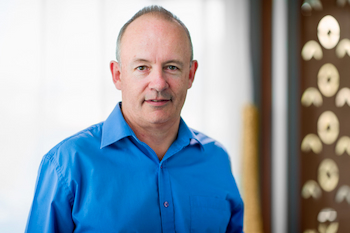
“Some of these genes will be targetable by drugs. One of the topical new proteins is the pro-survival protein, BCL-XL, which makes cells live longer. That’s the reason why people with ET have too many platelets in the blood, it’s the reason why people with PV have too many red cells. BCL-XL is targetable by a new drug called navitoclax.
“So targeting this protein makes sense as an alternative or in addition to ruxolitinib,” he said.
“We’re also trying to use complicated research genomics to find new types of genes that could be either biomarkers of fibrosis, to monitor patients to see if they are heading towards fibrosis, or used as drug targets, to find drugs. Charlene Lam and David Kipp are driving this work in the team.
“The lab undertakes preclinical research and we’ve developed a mouse model of myelofibrosis that we can use to test drugs in before they go into humans.”
About myeloproliferative neoplasms
Prof. Perkins describes MPNs as “a chronic blood cancer”.
“They are due to mutations in key driver genes that cause excess production of blood cells and, except for very rare cases, nearly all of them are non-inherited,” he explained.
“They’re a cancer accident that happens as you get older.”
The incidence of MPNs is not well known in Australia, but Prof. Perkins is working with the ALLG to set up a registry for MPNs.
“We’ll be able to answer that question more accurately once all MPN patients are properly registered,” he said.
A lot of these patients don’t go on the cancer registries because they never get a bone marrow biopsy. So, there is no formal pathology diagnosis that is automatically listed on cancer registries.
“I think we have an underestimate of the true incidence of MPNs in Australia. They are certainly commonly seen by haematologists all around the country.”
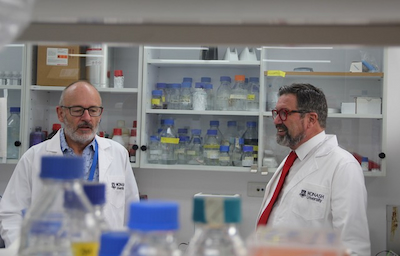
MPNs affect males and females equally and can occur in the young, with certain types, like juvenile myelomonocytic leukaemia, occurring predominantly in children and adolescents, “partly because there’s often an inherited genetic component associated with these ones”.
There’s a gradual increase in incidence with age, and MPNs cover the age spectrum from teenagers through to being quite common in the 30-40 age group, then increasingly common in the 60s, 70s, and beyond.
Essential thrombocythaemia – the most common MPN – can occur in teenagers, although that’s not common, all the way up to 90-year-olds.
Polycythaemia vera tends to be “a disease of middle age rather than old age”. It commonly affects those in their 30s and 40s, then is more common in the 40s and 50s age bracket.
Myelofibrosis occurs following a diagnosis of PV or ET, where it’s really the same disease and a consequence of having it for long enough to progress to myelofibrosis, or MF can happen out of the blue (de novo). It covers the age spectrum from the 30s and 40s, with incidence increasing in 50- and 60-year-olds.
“I look after all MPNs,” said Prof. Perkins. “But myelofibrosis is at the end of the spectrum and we need to be doing better as haematologists in managing these patients because the drugs we currently have are not curative.
“It’s an incurable disease without a bone marrow transplant, so patients get into trouble and need help. That’s the reason there are active clinical trials in myelofibrosis at the moment, and that’s why I’m particularly interested in myelofibrosis; because there’s more of a need there.”
And the greatest need in MF is “a drug that works better”.
“In general, none of the MPNs are curable diseases, and that’s not great, even though patients live a long time with them,” said Prof. Perkins.
“The first question I usually get asked by my patients is, ‘can you cure me?’ And usually, the direct answer is ‘not really, unless you have a bone marrow transplant and that’s risky’.
“A good contrast is another disease that’s similar to MPNs – chronic myeloid leukaemia, which is often curable with tyrosine kinase inhibitors [e.g., imatinib, nilotinib, dasatinib].
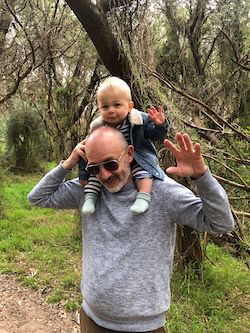
“We would love such a drug to be available and effective in MPNs, but we don’t, so there’s a need for a lot of research and clinical trials in this space,” said Prof. Perkins, principal investigator of seven different myelofibrosis clinical trials at the Alfred.
New drugs and clinical trials on the horizon for MPN
Prof. Perkins describes the main treatment for MPN, ruxolitinib (Jakavi®), as “a very good drug for controlling symptoms and slowing progression of the disease to MF”.
And there are “lots of things” on the horizon – new drugs that are likely to be active in combination with ruxolitinib, and alternative drugs to ruxolitinib that attempt to target the cancer stem cell or try to control the disease better.
“So, there are lots of trials available, both internationally and in Australia; yet eight out of 10 people don’t need to go on a trial. These patients are managed and followed quite well,” said Prof. Perkins.
“Most patients with the chronic-phase MPNs, PV and ET, live decades without much more than a bit of aspirin and maybe hydroxyurea. The first thing we learn in medicine is to ‘do no harm’, so most of these patients probably don’t need to go on trials.
“However, many patients will eventually get in trouble if they live long enough to get myelofibrosis or acute leukaemia,” said Prof. Perkins.
“If you’re a 70-year-old, and someone says you’ve got another good 20 years ahead of you, you’re likely to accept that, but if you’re a 25-year-old, and you’ve got a good 20 years ahead of you, dying at 45 is not so such a palatable option.
“It depends on your perspective, where you are in the age spectrum, and what your life goals are.
“For established MF, one can get ruxolitnib on the PBS and we know it will help, but we also know it won’t cure anybody with MF. Patients will eventually get into trouble.
“One could put patients on a trial at that point when they fail ruxolitinib.
“However, there is increasing interest in acting earlier and harder in MF, i.e., at the beginning of the diagnosis of MF. The hope is that putting people on an early trial might cure them, right there and then, before additional mutations accumulate over time.
“That decision is very hard and very patient-specific, and requires a lot of discussion with the patient and their family to decide what they really want to do. A trial at the beginning of the MF journey or a trial at the end of the MF journey when ruxolitinib has failed?” said Prof. Perkins.
“That’s a question for which I don’t have an answer. It’s an ongoing debate amongst haematologists and patients as to when to intervene.
“There are issues with trials; they’re not at every centre and patients don’t like travelling. And there’s a good argument that ruxolitinib is a good drug, so why not give that a go first?”
“The alternative argument is – there are trials out there now that combine new drugs upfront with ruxolitinib. So if you want to take the risk and the inconvenience of a trial, then why not?”
Clinical trials in myelofibrosis
Prof. Perkins said, while most of the trials were international studies, Australian trials were being developed, mostly through the ALLG.
“There are a lot of pharma-sponsored international trials that are quite good at the moment, with drugs that try to kill the cancer stem cell and reduce the fibrosis [scarring] directly,” he said.
“These drugs amplify how ruxolitinib, which is a kinase inhibitor, works. They are different types of kinase inhibitors that may or may not be better. We don’t know until we do the trials.
“Other classes of drugs being trialled are telomerase inhibitors and navitoclax (discussed earlier).
“Navitoclax is in the venetoclax family of drugs. Venetoclax has revolutionised the treatment of lymphoma, chronic lymphocytic lymphoma and acute myeloid leukaemia, but it has no effect in myelofibrosis. On the other hand, navitoclax works very well in MF mouse models. We don’t know if it works in humans well yet… that’s what the trials will find out,” said Prof. Perkins.
Navitoclax trials are underway at the Alfred in Melbourne and at other major cities in Australia.
There also are trials of alternative tyrosine kinases that inhibit JAK2, e.g., momelotinib, pacritinib, and fedratinib.
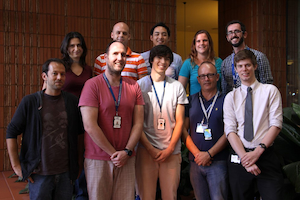
“Fedratinib is known reasonably well internationally because it’s the second drug approved by the FDA in the U.S. for the treatment of myelofibrosis,” said Prof. Perkins.
“There’s a large international trial for people who have failed ruxolitinib. It’s fedratinib against best available therapy and its design can help the decision of whether fedratinib becomes available on the PBS in Australia, like it is in America.
“We’re interested in participating in big trials that will tell us if it is worth lobbying the government to include it in the next round of drugs that are available here,” he said.
“Pacritinib is an exciting drug and I’ve been involved in pacritinib trials for 10 years. It’s a second-line drug for people at the end of the MF journey, who haven’t got any other options.
“It’s quite a useful drug. It doesn’t cure the disease but gives patients a second chance to do quite well when they’re not able to take rituximab anymore because it’s too toxic for them.
“Momelotinib has also been around for a long time and it’s particularly good for improving the anaemia that is a common complication of ruxolitinib therapy. We often find patients who move on to momelitinib don’t need transfusions anymore, which is a great benefit to them.
“They can travel around the country in their caravan for two months, instead of staying put at home and going in for their transfusion every two weeks. I have a couple of grey nomads who are desperate to get back to their caravan once COVID is gone.”
Prof. Perkins then said there were “exciting early trials” including the ADORE platform trial which is currently looking at five new drugs in combination with ruxolitinib.
“Many of these are completely different pathway drugs that are exciting, but it’s a Phase I/II trial that’s only at a few centres in Australia. We run it at the Alfred for the right kind of motivated patient,” he said.
“The trial is designed to try and find the best combinations. After the phase one component, the company (Novartis) will meet with the principal investigators and decide which are the best combinations to take forward into Phase II trials.”
Choosing the right clinical trial is hard
Prof. Perkins said, “trying to decide the best way forward in myelofibrosis is a very murky area at the moment.
“It’s not easy to make the right decision, it’s not easy to choose the right trial.”
“We’re not sure how to pick a winner at this point, but we’ll know a lot more in a few years’ time.
“It takes quite a bit of experience to know what all the options are, and a lot of haematologists don’t see much myelofibrosis, so they’ll send their patient to a big centre. And often, we send the patient back saying, ‘they’re doing fine where they are now. They don’t really need to change and they don’t need a trial’.
“Or sometimes we decide, if a patient has a particular problem, they might benefit from a specific trial. It’s horses for courses, depending on the current issue with MF.
“And I should say, with all these trials at this stage, we cannot guarantee any of them are going to cure anybody right now, so we still should remember the option of a bone marrow transplant in fit younger patients,” said Prof. Perkins.
“An experienced haematologist who’s used to treating myelofibrosis will have an open discussion with their patient and try and make the right decision.
“Another option is for patients is to attend educational meetings where Australian and international experts can give their opinion on these things. Also, my advice is to talk to the Leukaemia Foundation, the MPN Alliance, and other advocacy groups.”
Bone marrow transplantation for younger patients with myelofibrosis
To have an allogeneic bone marrow transplant or not is “a big decision”.
“More and more, we have multidisciplinary meetings with geneticists, clinicians and molecular pathologists to discuss individual cases and whether they should have a bone marrow transplant or not,” said Prof. Perkins.
But the risk of transplant-related mortality is “quite high”, he said.
“Thirty percent of patients don’t live 100 days post-transplant, so it’s a big decision to make if you’re young and have a family. Do you want to take that risk?
“But the benefit is the relapse rate is less than for AML or ALL. Once you get through that first 100 days and get over the graft versus host disease, there’s a light at the end of the tunnel of probable cure,” he said.
The role of ruxolitinib
Ruxolitinib was listed on the PBS in 2014, and Prof. Perkins said, “the thought then was that we wouldn’t transplant patients anymore, we’d treat them with ruxolitinib”.
“That hasn’t panned out, unfortunately, so allogeneic bone marrow transplantation for myelofibrosis is done much more frequently now than it was five years ago.
“Most people with myelofibrosis heading towards a transplant have a few months on ruxolitinib to reduce the risk. If you can get on ruxolitinib before your transplant, you do better,” he explained.
While there are cases of people “doing fine on ruxolitinib for 10 years, others are on it for 12 months and fail quickly”.
On average, Prof. Perkins said people can stay on ruxolitinib for three to five years,
“It buys them time, and they feel a lot better, so it buys them quality of life as well. They have a lot more energy, a lot of the symptoms go away, they can have a holiday and enjoy life.
“Some people can live a very long time on ruxolitinib,” said Prof. Perkins.
“In summary, treatment decisions for patients with MPNs, particular myelofibrosis, are very complex and very dependent on individual circumstances as well as disease behaviours and genetics. My advice to patients is to seek second opinions and engage with local and national advocacy groups such as the Leukaemia Foundation, MPN Alliance, and Ruby Red Foundation.”
Last updated on January 3rd, 2023
Developed by the Leukaemia Foundation in consultation with people living with a blood cancer, Leukaemia Foundation support staff, haematology nursing staff and/or Australian clinical haematologists. This content is provided for information purposes only and we urge you to always seek advice from a registered health care professional for diagnosis, treatment and answers to your medical questions, including the suitability of a particular therapy, service, product or treatment in your circumstances. The Leukaemia Foundation shall not bear any liability for any person relying on the materials contained on this website.